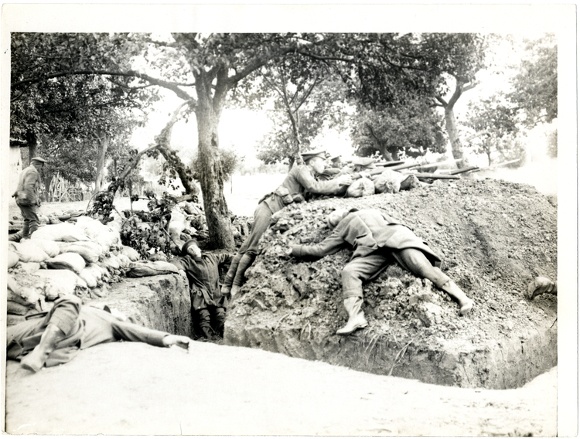Wilfred Owen, selected poems Contents
Insensibility - Imagery, symbolism and themes
Imagery in Insensibility
Since Insensibility is one of Owen’s longest poems, he has space both for figurative and literal images. Some of his more down to earth descriptions of life at the front are juxtaposed with metaphors which heighten our awareness of the horror.
Realism
The brutality of war expressed in such phrases as ‘men, gaps for filling’ l.9, is so chilling that it needs no elaboration. Neither does ‘alive, he is not vital overmuch’, l.44 nor its opposite the ‘dying, not mortal overmuch’ of l.45.
Metaphor
In stanza 1 Owen creates a brutal metaphor to show the horrors to which men need to become insensible. He describes the floors of the trenches as being ‘cobbled’ a reference to the cobble stones used to strengthen roadways. Here however the cobbles are skulls; the ‘brothers’ l.5 of those left to fight on.
In stanza 2 Owen creates an extended metaphor based on the mathematical problems created by loss of the life. Since these losses are so unpredictable and unquantifiable, the men choose not to rack their brains about it (‘Dullness’ l.14) or simply leave their fate in the hand of the personified ‘Chance’ l.16, whose ‘strange arithmetic’ is ‘simpler’ than even working out their wages (to ‘take the King’s shilling’ is a euphemism for signing up to join the army). It is far beyond the soldiers to keep a tally ‘check’ on the way in which the armies of men are ‘decimated’.
The cruellest metaphor is in stanza 3 where Owen gives us a reason for the insensibility of the ‘happy warriors’. They have had their feelings ‘ironed’ or cauterised l.28. This was a medical process often used in the war to prevent infection, gangrene and ultimate amputation. It involved a red-hot iron being applied to the wound which would destroy flesh in the immediate vicinity and thereby halt the spread of infection, saving life.
There is a moving metaphor, half hidden as a reality, at the end of stanza 4. Here the ‘wise’ observers of war:
The long, forlorn, relentless trend
From larger day to huger night
Part of a soldier’s routine is to march; here Owen is suggesting a much more final movement: the march from life to death.
Symbolism
It could be said that most of Insensibility is symbolic of the horrors of war and the callousness of those not involved.
The following words and phrases stand out as powerful symbols:
- Poet’s tearful fooling l.8. Here Owen is presenting the poetry of war as either sentimental or useless
- All things red l.23. This is a simple, brutal symbol for all the bloodshed of the war
- Laugh among the dying l.30 symbolises the survival technique by which the living survive among the dead – many soldiers, like doctors, developed a ‘gallows humour’ as a way of coping with the prevalence of death
- ‘Last sea’ and ‘the hapless stars’ of l.56,’ these shores’ of l.57 are all symbols of death and dying, echoing the classical Greek idea that the final journey of the dead is to be ferried across the River Acheron by Charon the ferryman
Investigating imagery and symbolism in Insensibility
- The imagery of Insensibility is harsh. Copy out the three most brutal images in the poem
- How might you use these quotations in an essay?
- Find comparable images from other Owen poems
Themes in Insensibility
‘My theme is war’
The horrors of war dominate this poem. Man’s inhumanity to man is dealt with in an ironic manner. In other poems Owen sees governments and politicians as being inhuman, here they are joined by the men who have been shelled and shocked and stunned by cannon into becoming dehumanised enough to ‘laugh among the dying’ l.30.
Brotherhood
 Love and brotherhood, compassion and concern are themes which Owen deals with elsewhere but which are in Insensibility turned on their heads. The living trample over the bodies of ‘their brothers’ in line 5 but ‘no one bothers’ l.11. Owen grapples with the fact that, as one of the ‘wise’, he is expected to be more ‘sensible’ than his men, yet survival is more likely if he is blunted to the tragedy around him, rather than having a soul besmirched with blood (as perhaps led to Owen’s breakdown).
Love and brotherhood, compassion and concern are themes which Owen deals with elsewhere but which are in Insensibility turned on their heads. The living trample over the bodies of ‘their brothers’ in line 5 but ‘no one bothers’ l.11. Owen grapples with the fact that, as one of the ‘wise’, he is expected to be more ‘sensible’ than his men, yet survival is more likely if he is blunted to the tragedy around him, rather than having a soul besmirched with blood (as perhaps led to Owen’s breakdown).
Survival
To survive men must let their ‘veins run cold’ l.2; that is they must not allow themselves to feel any human warmth. The men who are ‘happy’ in Owen’s nightmare world are those ‘Whom no compassion fleers’. Even compassion has become a monster. In Insensibility Owen is showing how this most human of emotions is seen as an enemy mocking the ‘happy man’ who cannot risk compassion if he is to survive the horror.
Investigating themes in Insensibility
- Insensibility is a poem about hopelessness. The ‘eternal reciprocity of tears’ suggests that the living will exchange tears with the dead for ever. Disabled is another Owen poem about the hopelessness of war. Compare and contrast it with Insensibility
- Compare Insensibility, as one of Owen’s longest poems, with another long poem, Strange Meeting
- Which do you find is the more effective of the two poems?
- Can you say why one is more effective than the other?
